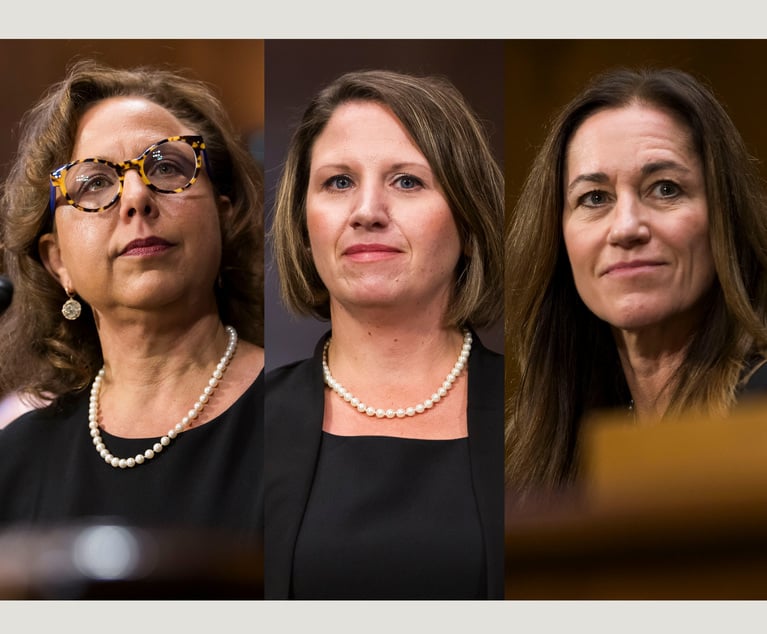Asset Titling: Why It Matters and How to Ensure Accuracy
A key part of properly implementing a client's estate plan is to ensure that assets are titled so that they flow in accordance with the client's true wishes at death.
September 05, 2019 at 01:54 PM
9 minute read
 Rebecca Rosenberger Smolen, left, and Amy Neifeld Shkedy, right, of Bala Law Group.
Rebecca Rosenberger Smolen, left, and Amy Neifeld Shkedy, right, of Bala Law Group.
A key part of properly implementing a client's estate plan is to ensure that assets are titled so that they flow in accordance with the client's true wishes at death. Unfortunately, many more times than we would like, this does not end up being the case, for one reason or another. We find this is a classic "you can lead a horse to water" issue. Despite our best efforts, many times a client's estate plan is partially thwarted because of asset titling that is inconsistent with the true goals and objectives of a client. Sometimes such mistitling simply causes a missed tax or asset protection planning opportunity, but, all too often, it literally causes assets to wind up in the hands of the wrong beneficiary. At times this can be remedied, but, more often than not it cannot.
In our article, "Survey Sheds Light on the Perils of TOD and POD Account Registrations" (published in the Legal on March 6, 2018), we covered the mistitling that regularly occurs when clients are encouraged to avoid probate by designating beneficiaries to directly receive the financial accounts on death (whether by filling out beneficiary designation forms or "payable on death" or "in trust for" titling). In that article, we explained how it would have been better for those account assets to have passed through the probate process and thus, through a decedent's well thought out estate plan.
A similar problem occurs when assets are inappropriately titled "joint with rights of survivorship." Many times, folks are also advised to do use such titling to avoid probate. Other times, this type of titling occurs in order to give a family member current access to accounts (including check writing authority) to assist a potentially incapacitated account owner. For such instances, the implementation of a power of attorney would generally have been significantly more appropriate. This is always the case when the goal of the account owner is for the account assets to pass in accordance with his estate plan (i.e., will and/or revocable trust) rather than to the surviving joint owner at death.
There are several hazards to the joint with right of survivorship titling for assets. First off, the assets may go to unintended beneficiaries (or to the right beneficiaries, but, in the wrong manner if a trust structure had been planned). Even if the surviving owner does cooperate to honor the true wishes of the deceased owner, it can be tricky in terms of evaluating whether or not the resulting transfers to the intended beneficiaries are taxable gifts by the surviving owner. Another problem is that taxable income that should be directly attributable to a decedent's estate, but is not reportable on the estate income tax return because it is taxable to the surviving joint owner, cannot be offset by estate administration expenses which would have been deductible against such income. This can cause significantly greater income tax to be payable than necessary. A final problem is that there is always a risk that the noncontributing joint tenant develops creditor issues and the joint asset may be vulnerable to such creditors' claims.
For second marriages, it can be disastrous when assets are titled as joint owners with rights of survivorship, so it ends up being a gamble as to which spouse's children inherit those assets. The children of the first spouse to die almost always lose out in that scenario. Even for long-time married couples with only common children, their estate planning needs are often best met by not having accounts be jointly titled with rights of survivorship (i.e., tenancy by the entirety property). For younger couples, such account titling may make sense both for the sake of simplicity in the event of a premature death and due to the creditor protection benefits that may be available for tenancy by the entirety property. However, for many couples, the benefits of leaving a direct legacy for the children from the first spouse to die often outweigh such potential protection. In such cases, it is better for spouses to either hold assets separately under their individual names, or in both names but as "tenants in common." That way, on the death of the first spouse, a portion of the tenant in common asset (typically 50%) will pass under the estate plan of the first spouse to die.
Up until the time that portability of the federal estate tax exemption was enacted in 2011, nearly all couples who were concerned about planning to minimize the hit of the federal estate tax were counseled to try to balance out their assets so that they were titled separately as close to 50/50 as possible rather than being titled jointly (or solely in one spouse's name). This is because, before the advent of portability, the federal estate tax exemption was "use it or lose it." So, if the exemption was $1 million per spouse, and the first spouse to die did not have any assets titled in his or her individual name (or all of the assets otherwise passed outright to the surviving spouse by designation or by virtue of joint ownership) the family would lose the tax benefit of the full exemption of the first deceased spouse. For $1 million of assets, when the tax hit was at the 55% rate, this could have been a "waste" of $550,000 of potential tax savings. The way to not waste the exemption was to either give assets equal to the exemption to the children at the death of the first spouse to die, or, more typically, to suspend them in a "credit shelter trust" for the benefit of the surviving spouse (and sometimes the children too) until both spouses had died.
Under current law with portability, in many cases there is no longer a concern with wasting the federal estate tax exemption available to the first spouse to die because any unused portion can now "port" to the surviving spouse. However, there remain several tax and nontax reasons to fund a trust with the exemption (or a portion of it) on the death of the first spouse (and a trust can only be funded at the first death if the first deceased spouse had assets owned titled in his or her individual name, and not in joint names). These days the tax reasons apply to fewer taxpayers than in the past, with the exemptions hovering at the $11 million-plus level, but, that can easily change under future tax laws as the country's politics evolve. As a backdrop, it's important to recognize that in the 1990s, the exemption was $600,000 per person, which would be much less than $11 million when taking into account inflation as indexed for today's dollars.
From a tax perspective there remain three main reasons to continue to plan to have the exemption of the first spouse be used, rather than just rely on portability, and for this to occur, each spouse must have sufficient assets titled in his or her individual name. First, the exemption from the federal "generation skipping transfer tax" is NOT portable. So, that remains a "use it or lose it" proposition which will be lost if all of a couples' assets pass to (or are otherwise wholly owned by) the surviving spouse on the death of the first spouse to die. Second, if there is a big time gap (as often is the case) between death of the first and second spouse, not only is there a greater chance of the federal estate tax laws changing, and potentially resulting in a reduced exemption for the surviving spouse, but, also, there is an opportunity for the assets using the exemption at the first death to significantly grow in value before the surviving spouse's death. The tax that would have been due in the surviving spouse's estate on any such appreciation in asset value value can be a significant savings for the family when the growth is "tax sheltered" in a credit shelter trust—recognizing that it is not uncommon for invested assets to double every 10 years or so. Finally, if the surviving spouse remarries, as often happens against expectations, any portion of the ported exemption which is not used through gifting prior to the new marriage will be forfeited.
There are also many nontax reasons to title assets so that a credit shelter type trust may be funded on the first spouse's death. A primary concern is protecting assets if the surviving spouse remarries. While prenuptial agreements can also provide some protection, a trust provides another layer of protection. Also, if the surviving spouse has creditor issues, whether due to nursing home costs, or for other reasons, a trust can protect some of the family's assets for the benefit of both the surviving spouse and the children. Another subtle, but valuable, benefit of a trust is that it gives the family the opportunity to have a legacy of funds attributable to the first spouse to die that will ultimately pass directly from that spouse to the children and grandchildren. While typically the primary benefit of such an arrangement is asset preservation, there is a palpable emotional component for most families as well in that it is a source of fortifying connectivity to the deceased family member.
Rebecca Rosenberger Smolen and Amy Neifeld Shkedy are members and co-founders of Bala Law Group. They focus their practices on tax and estate planning.
This content has been archived. It is available through our partners, LexisNexis® and Bloomberg Law.
To view this content, please continue to their sites.
Not a Lexis Subscriber?
Subscribe Now
Not a Bloomberg Law Subscriber?
Subscribe Now
NOT FOR REPRINT
© 2025 ALM Global, LLC, All Rights Reserved. Request academic re-use from www.copyright.com. All other uses, submit a request to [email protected]. For more information visit Asset & Logo Licensing.
You Might Like
View All
Pa. Federal District Courts Reach Full Complement Following Latest Confirmation

The Defense Bar Is Feeling the Strain: Busy Med Mal Trial Schedules Might Be Phila.'s 'New Normal'
7 minute read
Federal Judge Allows Elderly Woman's Consumer Protection Suit to Proceed Against Citizens Bank
5 minute read
Judge Leaves Statute of Limitations Question in Injury Crash Suit for a Jury
4 minute readTrending Stories
Who Got The Work
Michael G. Bongiorno, Andrew Scott Dulberg and Elizabeth E. Driscoll from Wilmer Cutler Pickering Hale and Dorr have stepped in to represent Symbotic Inc., an A.I.-enabled technology platform that focuses on increasing supply chain efficiency, and other defendants in a pending shareholder derivative lawsuit. The case, filed Oct. 2 in Massachusetts District Court by the Brown Law Firm on behalf of Stephen Austen, accuses certain officers and directors of misleading investors in regard to Symbotic's potential for margin growth by failing to disclose that the company was not equipped to timely deploy its systems or manage expenses through project delays. The case, assigned to U.S. District Judge Nathaniel M. Gorton, is 1:24-cv-12522, Austen v. Cohen et al.
Who Got The Work
Edmund Polubinski and Marie Killmond of Davis Polk & Wardwell have entered appearances for data platform software development company MongoDB and other defendants in a pending shareholder derivative lawsuit. The action, filed Oct. 7 in New York Southern District Court by the Brown Law Firm, accuses the company's directors and/or officers of falsely expressing confidence in the company’s restructuring of its sales incentive plan and downplaying the severity of decreases in its upfront commitments. The case is 1:24-cv-07594, Roy v. Ittycheria et al.
Who Got The Work
Amy O. Bruchs and Kurt F. Ellison of Michael Best & Friedrich have entered appearances for Epic Systems Corp. in a pending employment discrimination lawsuit. The suit was filed Sept. 7 in Wisconsin Western District Court by Levine Eisberner LLC and Siri & Glimstad on behalf of a project manager who claims that he was wrongfully terminated after applying for a religious exemption to the defendant's COVID-19 vaccine mandate. The case, assigned to U.S. Magistrate Judge Anita Marie Boor, is 3:24-cv-00630, Secker, Nathan v. Epic Systems Corporation.
Who Got The Work
David X. Sullivan, Thomas J. Finn and Gregory A. Hall from McCarter & English have entered appearances for Sunrun Installation Services in a pending civil rights lawsuit. The complaint was filed Sept. 4 in Connecticut District Court by attorney Robert M. Berke on behalf of former employee George Edward Steins, who was arrested and charged with employing an unregistered home improvement salesperson. The complaint alleges that had Sunrun informed the Connecticut Department of Consumer Protection that the plaintiff's employment had ended in 2017 and that he no longer held Sunrun's home improvement contractor license, he would not have been hit with charges, which were dismissed in May 2024. The case, assigned to U.S. District Judge Jeffrey A. Meyer, is 3:24-cv-01423, Steins v. Sunrun, Inc. et al.
Who Got The Work
Greenberg Traurig shareholder Joshua L. Raskin has entered an appearance for boohoo.com UK Ltd. in a pending patent infringement lawsuit. The suit, filed Sept. 3 in Texas Eastern District Court by Rozier Hardt McDonough on behalf of Alto Dynamics, asserts five patents related to an online shopping platform. The case, assigned to U.S. District Judge Rodney Gilstrap, is 2:24-cv-00719, Alto Dynamics, LLC v. boohoo.com UK Limited.
Featured Firms
Law Offices of Gary Martin Hays & Associates, P.C.
(470) 294-1674
Law Offices of Mark E. Salomone
(857) 444-6468
Smith & Hassler
(713) 739-1250





